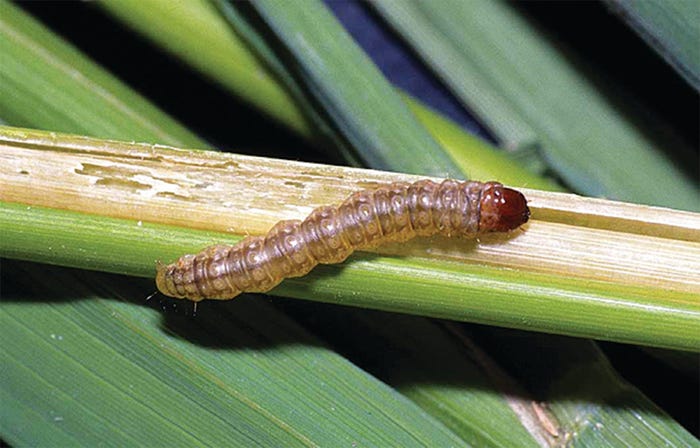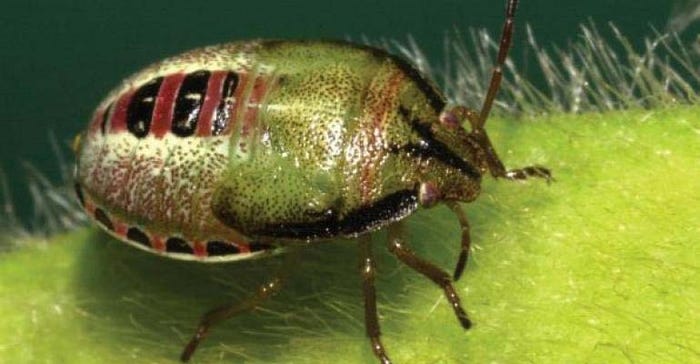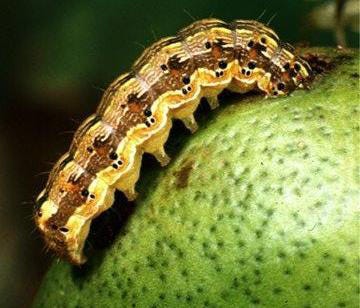
CORN INSECT OUTLOOK
What’s the expected insect spectrum and intensity for Mid-South corn in 2018? We asked regional university entomologists to offer insight into what growers may be facing next year, and to mention a few tools that could be of help.
Tennessee: No surprises are expected in Tennessee corn in 2018, says Scott Stewart, University of Tennessee Extension entomologist at Jackson. “Between seed treatments and Bt technology, we just don’t have consistent major problems in corn. Of course, there are always special circumstances where you might want to bump the rate on a seed treatment, or use an additional at-planting treatment.
“We’re seeing more corn earworm larvae and injury to corn tips in Bt corn, but our research indicates it’s not causing a significant economic effect. However, those worms are being pre-selected for tolerance to Bt toxins, and when they migrate to cotton, they can cause an economic effect in that crop.
“Additionally, we still have some conventional corn being grown, and sometimes have issues with either southwestern corn borer or European corn borer on non-Bt acres. The intensity of those worms depends on the winter, and we’ve had two warm winters in a row.”
Louisiana: Growers planning to plant corn behind corn in 2018 are urged to use a substantial seed treatment, says Louisiana State University Entomologist Sebe Brown at Winnsboro.
“Our below-ground corn pest complex, which includes wireworms and southern corn rootworm, can cause economic damage and crop delay. I don’t recommend anything less than Poncho 500, if it’s corn behind corn, especially if they don’t run anything in-furrow, such as Counter or Force. You just have to be careful with some of the in-furrow insecticides that have organophosphates in them; when you mix them with some herbicides, it can cause antagonism issues that can stunt corn. If you’re planting on rotated ground, you probably can use Poncho 250 for below-ground insect control.
“This year, we saw a lot of ear feeders, specifically corn earworms. Normally, ear feeders don’t contribute a whole lot to yield loss when corn is planted timely.
“If you plant corn in a timely window, you might get some tip feeding and ear feeding by worms, but the damage won’t contribute to yield loss.”
Arkansas: Cutworms were especially bad in Arkansas corn this past season, partly due to the previous mild winter, and more stink bugs attacked seedling corn than in the past. Many growers are using cover crops, which can exacerbate cutworm and stink bug problems.

Southwestern corn borer
“I’m basically recommending that if corn growers plan to plant into a cover crop, they go with at least a 500 rate, and consider using the highest rate, on their seed treatment,” says University of Arkansas Entomologist Glenn Studebaker at Keiser.
The state’s conventional corn acreage has expanded due to a local poultry producer who markets chickens fed on non-GMO grain, and who pays growers a premium on conventional corn. About 35,000-plus acres of conventional corn was planted, mainly in northeast and central Arkansas.
“That means we closely track southwestern corn borer, which is a major pest in non-Bt corn,” Studebaker says. “We saw a pretty good blip on this pest, mainly in three counties, so growers in that area were alerted and they sprayed. We recommend that growers planting conventional corn use a southwestern corn borer pheromone trapping program. Our threshold is 50 per trap per week for the first generation, and over 100 per trap per week for the second generation, which usually are the ones that cause problems. That usually occurs around the end of June or the first of July.”
Mississippi: "The biggest insect problem in 2017 was stink bugs in seedling corn,” says Angus Catchot, Mississippi Extension entomologist at Starkville. “That problem doesn’t always pop up, but we had to treat a lot of acres this past season for stink bugs, which might have had something to do with the mild winter.
“We also think the damage may be occurring much earlier than we once thought, so we recommend scouting for stink bugs at an even earlier stage. A lot of the damage might be occurring around V1 or V2. Seed treatments have some effect on stink bugs, but it’s not a standalone because they have to feed to ingest the material. So, we need a good scout-and-spray approach, using foliar sprays of bifenthrin, when economic thresholds are reached.”
SOYBEAN INSECT OUTLOOK
Mid-South soybean growers learned in 2017 just how costly redbanded stink bugs can be. Area university entomologists offer suggestions on handling this and other insect pests in 2018.
Mississippi: The insect story for the past season was the redbanded stink bug, says Angus Catchot, Mississippi Extension entomologist at Starkville. “Many growers found out how damaging and costly this pest can be. It’s very sensitive to cold winters, so the severity of this winter will dictate the level of the problem in 2018, or if we’ll even have a problem.

Redbanded stink bug
“We’ll conduct surveys of ditchbanks and watch the weather to see if the redbanded stinkbug is able to overwinter again in Mississippi and other Mid-South states. We’ll know before the 2018 season starts. The earlier we can plant the bulk of the soybean crop, the fewer sprays we’ll have to make for this pest, and many others. The sweet spot for planting soybeans ranges from end of March to about April 20, depending on weather. This early window results in the best yield potential and minimizes insect sprays.”
Bollworms can be expected again in 2018, Catchot says, but they usually are effectively controlled by foliar insecticides — it’s easier to optimize spray coverage in soybeans than in cotton. Additionally, the kudzu bug is present in some Mississippi soybean fields, but it has not become a major pest. But, high populations left untreated can reduce yields, so they need to be watched.
Louisiana: The time soybeans are planted is the determinant of most soybean insect issues in the state, says Louisiana State University Entomologist Sebe Brown. Regardless of whether planting is early or late, growers are urged to use an insecticide seed treatment.
“We see a yield benefit with a seed treatment when beans are planted very early, with good temperatures and slow growth,” he says. “We also see an economic benefit with a seed treatment on beans planted very late, typically behind wheat, or where you have a dirtier field that has three-cornered alfalfahoppers and other insects that feed on soybeans.
“I recommend using a seed treatment for any soybeans planting date,” Brown says, “because Louisiana weather is so dynamic that nobody can predict what it will do. The temperature might be hot for a week, then turn off cold for two weeks. In fact, I recommend a seed treatment for every agronomic crop that we grow in Louisiana.”
If a frigid winter occurs, redbanded stink bug numbers are expected to be low at the start of the 2018 season. “South Louisiana will have to deal with them, regardless, because it doesn’t get cold enough south of Alexandria,” Brown says. “If we have another mild winter, I recommend to our growers that they budget for at least three to five stink bug applications. If you plant early, you might get away with one or two applications; if you plant late, you might wind up using all five.”

Soybean looper
Louisiana growers also can count on having soybean loopers every year, and the later the beans are planted, the more insect pressure that will occur. “The earlier you can plant beans, the more money you will save on insect sprays,” Brown says. “Growers who get in the last week of March and the first week of April can be harvesting in late July, early August. They miss late-season rains, insects, and hurricanes, and they do well on yield.”
Arkansas: In 2017, the state’s soybean growers were still fighting redbanded stink bugs as late as October, says University of Arkansas Entomologist Gus Lorenz at Little Rock. How big a problem they will be in 2018 depends entirely on the winter, he says. “A cold winter, with extended periods below freezing — unlike what we’ve had the previous two years — could eliminate redbanded stinkbug as an economic pest in soybeans.”
Weather also determines the intensity of pressure for the state’s other key insect pests, including soybean loopers, fall armyworms, and southern green stink bug. ��“They’re usually migratory, but mild winters have caused a lot of overwintering of these pests here in Arkansas,” Lorenz says. “As a result, this past season they started out earlier and in bigger numbers than normal, and were able to build up to extremely high populations that caused problems.”
Bollworms, the No. 1 pest in Arkansas, were able to build in 2017, not only because of the previous mild winter, but also due to pre-selected ones that came through traited Bt corn. “We had a much higher survival than we’ve seen in previous years,” he says. “When you have a higher survival rate coming through corn, then you have more resistant worms getting into the other crops, including soybeans, cotton, and grain sorghum. So, we saw a breakdown of Bt traits in corn, soybeans, and cotton. In 2018, we’ll watch how worms are doing in traited corn hybrids, because their survival rate will bleed over into soybeans and cotton.
“Many insect pests are going into overwintering this year because of the extremely high numbers that we’ve had this season,” Lorenz says. “We need some good overwintering mortality to knock numbers down, and hopefully stunt the increase of migratory pests.”
Tennessee: Two warm winters in a row have complicated the Mid-South soybean insect spectrum, says Scott Stewart, University of Tennessee Extension entomologist at Jackson. “The two biggest problems we have in soybeans are corn earworms and redbanded stink bugs. West Tennessee experienced a little redbanded stink bug problem in 2017, but if we have another mild winter, it could potentially become an issue in our soybeans in 2018. On the other hand, if we have a hard winter, we might not see this pest in the upper Mid-South next year. It is very cold-sensitive — but it’s also very mobile and hard to control.
“The kudzu bug has not materialized into the pest problem we originally thought it might be,” Stewart says. “Part of that is due to some of the biological controls. A naturally-occurring fungus, Beauveria bassiana, has done a remarkable job of holding kudzu bug populations in check, and some areas also have a parasitoid that attacks the eggs. But, it’s still a significant problem in some places, and we’ve had some scenarios in West Tennessee where we had to spray for kudzu bugs. A hard winter would help us with this pest, too.
“Some of the corn earworm problems are driven by larvae escapes in corn; those worms migrate into soybeans and cotton, where they can cause economic damage. We also always keep an eye on soybean loopers and stink bugs.”
COTTON INSECT OUTLOOK
Cotton insects are variable — there are good years for some, and bad years for some. That’s what insects do, say Mid-South university entomologists who offer insight into which pests might dominate in 2018, along with tips for what you can do about them.
Tennessee: The three big insect players in the state’s cotton are thrips, tarnished plant bugs, and bollworms, according to Scott Stewart, University of Tennessee Extension entomologist at Jackson. “We’re pretty much status quo on thrips control. We know we have some resistance issues with the neonicotinoids, but we’re managing that problem, and I don’t foresee any big changes in 2018.
“The Mid-South had a lighter than normal plant bug year in 2017, so my guess is that next year we won’t. But, plant bugs are a manageable problem, and we do a good job with the available tools. It would be nice, though, to have some more insecticide options.”
A big issue that concerns everyone is the increasing resistance to Bt in bollworm populations. “We’re not seeing the level of bollworm control that we’ve had in the past with the Bt technologies: Widestrike, Bollgard II, and TwinLink,” says Stewart. “We will still be growing those traited varieties in 2018, so we’ll have to be a little more aggressive in spraying bollworms, and invest a little bit more money in insecticides to control the problem. The other option is to switch over to some of the newer technologies: Widestrike 3, Bollgard III, and TwinLink Plus.”
Some growers spray a high rate of Orthene, or a pyrethroid+Orthene tank mix to kill some of the bollworm moths, possibly reducing egg lay. “However, bollworms are very migratory pests, and are constantly swarming in an area, so spraying just some fields probably has a negligible impact,” he says. “We’re also seeing less control of bollworms than we saw in the past with pyrethroids, so growers are switching over to newer chemistries, which are more expensive, but more effective."
Tennessee also experienced more problems with spider mites and aphids in 2017 than normal, and Stewart expects issues to continue because of the well-documented aphid resistance to neonicotinoids. “With spider mites, in past years, we grew a lot of Liberty-tolerant cotton and sprayed two applications of Liberty over that cotton.

Corn earworm in cotton
“Liberty is pretty good at controlling spider mites, even though it’s a herbicide. So, those two early season Liberty applications suppressed mites. This past year, the dynamics changed with the big shift to dicamba-tolerant cotton, and we had a lot less Liberty applied. I think that’s one reason we had more consistent spider mite problems in 2017.”
Louisiana: Cotton growers in the state can always count on having thrips, says Louisiana State University Entomologist Sebe Brown at Winnsboro. Fortunately, they have several seed treatment options to control the early season pest.
“For example, Aries seed treatment offers great protection, and Gaucho also performs well in our state,” he says. “Depending on environmental conditions, you might have to come back with a rescue spray. We also can use an in-furrow application of Ag Logic 15G aldicarb, which performs as well as the old Temik. If you have nematodes, I highly recommend running aldicarb.”
Cotton growers can also count on plant bugs. Brown says Transform provided really good control this past season, and all the standards, including acephate and Bidrin, performed well. “We recommend rotating chemistries, and using Diamond insect growth regulator every other application. I especially like the higher rate of Diamond, 8 ounces to 9 ounces.
Escape bollworms were really bad in Louisiana cotton this past season, he says. “I saw escapes in all three technologies:
Widestrike, Bollgard II, and TwinLink. For 2018, I recommend planting Widestrike 3, Bollgard III, and TwinLink Plus — all have the Vip trait. We’re partly seeing worm escapes in older Bt technology because they are pre-selected in Bt corn.
“Prevathon and Besiege are working well for controlling worms. Growers just need to make sure they have good coverage. They may need to use higher gallonage — a minimum of 10 gallons per acre by ground — and higher rates: Prevathon 20 ounces per acre, and Besiege 10 ounces.”
Arkansas: Spider mites continue to be a problem in northeast Arkansas cotton; the pest survives on many hosts and gets an early start. There also may be some association with cover crops and no-till that help to exacerbate the issue.

Tarnished plant bug
“Spider mites got an early start this past season,” says University of Arkansas Entomologist Gus Lorenz at Little Rock. “We rely almost entirely on neonicotinoid seed treatments, which don’t help the matter at all. Spider mites also blow up after growers make a couple of applications of organophosphates or pyrethroids for thrips. Sometimes it seems when cotton comes out of the ground, it’s got mites on it.”
Arkansas producers have also been seeing more resistant bollworms; the number of escape bollworms coming through traited corn means they have already been exposed to Bt before they get to cotton. “We sprayed more acreage in 2017 for bollworms in cotton than ever before, and actually sprayed in areas where we haven’t had to spray before — which indicates we’re losing control in Bt cotton,” Lorenz says.
“Additionally, we just had a big year of bollworm numbers; we had a rolling population that just kept coming in — there weren’t distinct generations. Our moth trap numbers weren’t higher than what we had in 2016, though, which indicates to me that there’s more survival of worms coming through the Bt technology in corn.”
Compared to other years, 2017 was a fairly light plant bug year, Lorenz says. Some growers battled populations in cotton next to corn, or CRP fields, or early-planted soybeans. “But overall, we were probably off one or two applications for plant bugs statewide this year. For whatever reason, the colder the winter, the greater the plant bug population. They overwinter in the state on wild hosts.”
Mississippi: Because of resistance to some neonicotinoid seed treatments, Mississippi recommends going to an imidacloprid-based seed treatment, and supplementing it with either an acephate overtreatment, acephate seed treatment, or acephate sprayed in-furrow to minimize foliar thrips sprays. “We had great success controlling thrips with this program in 2017,” says Angus Catchot, Mississippi Extension entomologist at Starkville.
Mississippi cotton growers made many sprays for bollworms in Bollgard II cotton in 2017. “Going into 2018, we need to take a hard look at the newer trait technologies, such as Bollgard III, WideStrike 3, and TwinLink Plus,” Catchot says. “Review the yield of these new varieties in county trials and state OVTs, and plant the ones best suited to your farm in order to minimize foliar sprays for bollworms.”
About the Author(s)
You May Also Like




